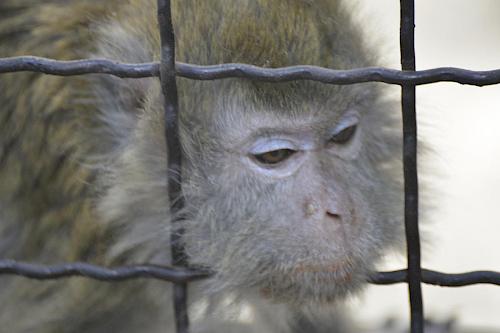
Ben Brock
Senior Wildlife Crime Analyst
Responding to corruption in the non-human primate supply chain for medical research
Financial institutions have the ability and the legal responsibility to identify and report the enabling payments and the proceeds of crime—including wildlife crimes that are facilitated by corruption. Increasing engagement and information-sharing between conservation practitioners and financial institutions is an important approach to counter and prevent wildlife trafficking. This blog post shares insights from a recent report generated by TRAFFIC wildlife crime analysts for anti-money laundering (AML) staff in financial institutions. The report summarises the corruption alleged in the US indictment: United States District Court Southern District of Florida 22-20340-CR-WILLIAMS/MCALILEY, associated with the alleged trafficking of wild primates for medical research. Increasing awareness of these possible methodologies is intended to help prevent the risk of similar suspicious financial activity in the future. The majority of the case details referenced in this post are sourced from the 2022 United States (U.S.) Indictment.
Understanding the threat
Macaques, including Long-tailed Macaques (Macaca fascicularis), are the major non-human primate resource used for biomedical research1 which develops new pharmaceuticals for human use. The increase in the production of biotherapeutics, drug therapy products where the active substance is extracted or produced from a biological source2, for HIV/AIDS research3 and most recently, research into COVID-19 treatments has led to increased global demand for these nonhuman primates in clinical testing4,5.
Long-tailed Macaques are the most highly traded species of primate in the world. The International Union for Conservation of Nature (IUCN) Red List classified Long-tailed Macaques as Endangered (EN) in 20226. To prevent overexploitation, permits are required for the international trade of Long-tailed Macaques due to their listing in Appendix II of the Convention on International Trade in Endangered Species of Wild Fauna and Flora (CITES). Yet, despite these protections, the CITES permit-based system has been targeted by corrupt actors numerous times7. At least part of the motivation for the illegal trade is assessed to be driven by the high value of these animals; the international trade in Long-tailed Macaques alone was estimated to be worth approximately USD1.25 billion between 2010 and 20198.
The indictment
The US indictment alleges that between 2017 and January 2022, the defendants arranged to illegally purchase additional Long-tailed Macaques from black market suppliers in Cambodia and Thailand to make up for the lack of supply of suitable monkeys at their breeding centres. The US indictment alleged that CITES staff within the Ministry of Agriculture, Forestry and Fisheries (MAFF) of the Government of Cambodia have facilitated:
- Securing fraudulently obtained CITES export permits which falsely identified wild-caught macaques as captive-bred;
- The supply of wild-caught macaques from Cambodian National Parks and protected areas for later sale and export;
- The supply of fraudulent Transport Permits which allowed macaques unsuitable for the export trade to appear to have been captive bred;
- To provide unofficial collection quotas, falsely suggesting that the populations were numerous enough to support a level of wild capture.
The risks
These alleged crimes bring three serious risks:
Illegally captured and misdeclared wild-caught animals could compromise the validity of clinical testing regimes as the animals are of unknown disease status. The animals may be immunosuppressed from the stress of the capture and the transport process and/or have been exposed to novel viral, bacterial, and parasitic agents any of which could undermine vaccine trials and compromise the research programs that they have been poached to fulfil.
Due to the close genetic relationship between non-human primates and humans, zoonotic pathogens are easily exchanged, which can lead to severe and potentially fatal infections in humans9. Wild-caught animals being fraudulently declared captive-bred represent a particular risk as protective measures may not be considered necessary when importing the animals, as the assumption would be that they have been born and raised in a monitored and controlled environment. It can be hard to detect certain infections spreading through a captive population following the introduction of illegally laundered wild-caught animals.
- Long-tailed Macaques are an Endangered species. For many years now, very large numbers of Long-tailed Macaques have been exported from Indonesia, The Philippines, Cambodia, and Viet Nam, among others, which trade experts considered as “extremely unsustainable” in 20226.
Trade in specimens of species listed in the CITES Appendices requires official trade documentation in the form of permits and certificates.
Corrupt officials can supply fraudulent documents which can disguise illegally captured wildlife as highly valuable, seemingly legal products. As such, these documents potentially have a significant value to criminals which can motivate cases of abuse involving corrupt practices. The paperwork needed to move illegal products can be forged or changed, and genuine documents can be bought from corrupt officials11. Falsely declaring the source of CITES-listed specimens is a common form of abuse7.

CITES officials as Politically Exposed Persons (PEPs)
TRAFFIC acknowledges and supports the critical work that officials from national CITES Authorities deliver in management and control of trade in threatened species. However, corruption threats are common to many senior staff within government office, and some of the money laundering threats can be partially mitigated through the politically exposed person (PEP) management system. (A politically exposed person (PEP) is defined by the Financial Action Task Force (FATF - the global anti money-laundering policy lead) as an individual who is or has been entrusted with a prominent public function.)
Therefore TRAFFIC recommends that payments and political donations from vested interest groups to CITES officials are considered for enhanced due diligence. Lists of CITES staff are available per country via the CITES website (https://cites.org/eng/parties/country-profiles) and could be considered for inclusion as PEPs on a risk-based approach.
Red Flag risk indicators
There are four risk indicators that may help to detect and prevent this type of alleged criminality:
- Question round figure payments, while this is amongst the oldest anti-money-laundering (AML) recommendations, the use of these types of payments in the indictment suggest that it is still relevant.
- Monitoring use of cash compared to other businesses of a similar profile and scale, again this is a well-known risk but its appearance here shows its ongoing relevance when combined with the trade threats outlined above.
In addition to these very well-known, but still prevalent, criminal methodologies, the US Financial Intelligence Unit, FinCEN, has identified indicators that occur most commonly with financial transactions linked to wildlife trafficking that are also relevant to the threat of laundering wild-caught animals.
- Prevalence of Import-Export and Logistics Companies, FinCEN’s analysis of wildlife trafficking-related SARs found international trade companies, including import-export, freight forwarding, customs clearance, logistics, travel agencies, or similar types of companies may be associated with wildlife trafficking, by either knowingly or unknowingly moving animals or animal-associated products or parts, or by being used as front companies for the movement or laundering of illicit proceeds.
- Transactions Referencing Wildlife-associated Care or Equipment, some illicit actors engaged in wildlife trafficking conduct transactions related to the purchase or maintenance of enclosures, aquariums, food, poaching-related equipment, large game equipment, or harnesses. Wildlife-related medication or veterinary services also may be associated with the storage or care of illegally trafficked animals. Additionally, transactions appearing to benefit medical or pharmaceutical research could be indicative of animals illegally trafficked for medical research.
Useful Resources for all stakeholders
Further practical guidance on how to respond to wildlife crime including corruption and money laundering has been published by the International Consortium on Combating Wildlife Crime, composed of the United Nations Office on Drugs and Crime (UNODC), the World Bank Group, Interpol and CITES themselves plus other partners.
Specific information on CITES Documentation fraud and corruption is available.
The US Financial Intelligence Unit, FinCEN, has identified indicators that occur most commonly with financial transactions linked to wildlife trafficking that can usefully be applied to this specific threat.
In order to submit a Suspicious Transaction Report (STR), one must have reasonable grounds to suspect that a transaction is related to a financial crime. The exact processes depend on which country you are in, but there is general advice available.
Resources for conservation practitioners
Conservation practitioners seeking to embed an 'engaging financial institutions' element into their programming to address conservation crime and corruption are encouraged to:
- Take this self-directed eCourse to learn how engaging the financial sector can help to reduce money-laundering and corruption linked to illegal wild species trade.
- Review these good practices for communicating with the financial sector to combat corruption linked to illegal wild species trade and money laundering, considering TRAFFIC interviews with representatives from major financial institutions.
- Explore this 2021 case digest developed by TRAFFIC, together with UNODC: An Initial Analysis of the Financial Flows and Payment Mechanisms Behind Wildlife and Forest Crime.
Notes:
The majority of detail within this case study comes from the US Indictment and from the Vanny group’s website.
Note on Indictments: after a US prosecutor studies the information from investigators and from speaking with other individuals involved, the prosecutor decides whether to present the case to the grand jury. When a person is indicted, they are given formal notice that it is believed that they committed a crime. The indictment contains the basic information that informs the person of the charges against them. An indictment is only an accusation and a defendant is presumed innocent unless and until proven guilty. (Related court documents and information may be found on the website of the District Court for the Southern District of Florida or at http://pacer.flsd.uscourts.gov)
The subjects in this case have been indicted but the case has not yet been tried and therefore no suggestion of guilt of the crimes discussed is placed with the individuals or companies described.
[1] Gardner Murray B., Luciw Paul A. Macaque models of human infectious disease. ILAR J. 2008;49(2):220–255. doi: 10.1093/ilar.49.2.220. - DOI - PMC - PubMed
[2] Carter P., Lazar G. Next generation antibody drugs: Pursuit of the ‘high-hanging fruit’ Nat. Rev. Drug Disc. 2018;17:197–223. doi: 10.1038/nrd.2017.227.
[3] J.M. Antony, K.S. MacDonald, A critical analysis of the cynomolgus macaque, Macaca fascicularis, as a model to test HIV-1/SIV vaccine efficacy, Vaccine., 33 (2015), pp. 3073-3083
[4] https://www.nc3rs.org.uk/events/minimising-NHP-use
[5] https://nprc.org/research/nprcs-further-collaborations-to-overcome-non-human-primate-shortage/
[6] Hansen, M.F., Ang, A., Trinh, T.T.H., Sy, E., Paramasivam, S., Ahmed, T., Dimalibot, J., Jones-Engel, L., Ruppert, N., Griffioen, C., Lwin, N., Phiapalath, P., Gray, R., Kite, S., Doak, N., Nijman, V., Fuentes, A. & Gumert, M.D. 2022. Macaca fascicularis (amended version of 2022 assessment). The IUCN Red List of Threatened Species 2022: e.T12551A221666136. https://dx.doi.org/10.2305/IUCN.UK.2022-2.RLTS.T12551A221666136.en. Accessed on 02 October 2023.
[7] Outhwaite, W. 2020. Addressing Corruption in CITES Documentation Processes. Targeting Natural Resource Corruption
[8] Hansen, Malene Friis & Gill, Mike & Briefer, Elodie & Nielsen, Daniel & Nijman, Vincent. (2022). Monetary Value of Live Trade in a Commonly Traded Primate, the Long-Tailed Macaque, Based on Global Trade Statistics. Frontiers in Conservation Science. 3. 839131. 10.3389/fcosc.2022.839131.
[9] Knauf, Sascha & Jones-Engel, Lisa. (2020). An Introduction to One Health and Neglected Diseases in Monkeys. 10.1007/978-3-030-52283-4_1.
[10] S. Zain, July 2020, Corrupting trade: An overview of corruption issues in illicit wildlife trade. Targeting Natural Resource Corruption


